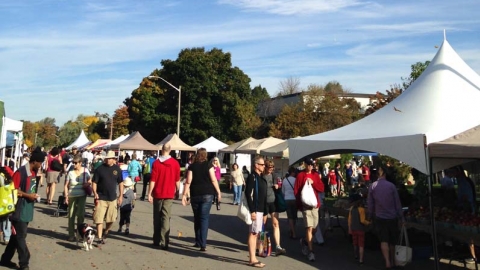The View from the Farm
The romantic sketch of the traditional farm on the side of the milk container is the scene many purchasers of local food are hoping to protect. The scene is idyllic — a place of beauty, hard work and the knowledge that bringing food to the nation’s tables creates an intrinsically good life. But the underbelly of that scene is quite different. It obscures many contradictions and tensions, hard work and determination, long hours, stress and loneliness.
The National Farmers Union (NFU), which promotes family farms as socially benign producers of food, concludes its report Losing Our Grip — 2015 Update: Erosion of Farmer Autonomy in Canada by describing a landscape of escalating farm debt, the hardships of seeking off-farm income to bolster the bottom line, and an erosion of the farm population as potential young farmers look elsewhere to earn their living. The last few decades of agriculture policy, focused on increasing commodity exports, have not been helpful — subverting the struggles of small family farms to survive and weakening local food systems. And yet, those farms are far from extinct.
From their farm north of Wakefield, Qué., Charlotte Scott and Richard Williams of Ferme Lève-tôt explain the benefits small-scale farming gives to them and the hundred customers who buy their organic vegetables at the local farmers’ market or through community- supported agriculture (an arrangement in which customers buy shares in a farm’s production at the start of the growing season).
Everyone wins, they say. For them, the farm provides a rewarding livelihood; for customers, it is a source of affordable and nutritious food. When asked if they are an alternative to the industrial model of agriculture, or part of a systems change, their response suggests they are “part of the new normal.” Despite the sheer size of the competing global industrial food system, Scott and Williams exemplify the hope often found among local food advocates.
The hope continues and even grows despite the odds. In 2010, approximately 60 per cent of Canadian farmers reported an average off-farm employment income of $18,371. Some farmers feel that the need to work off the farm amounts to a personal — and unfair — subsidy to farm products.
The vulnerability here partly comes from the power of large retailers, who can impose (often arbitrary) quality-control standards that allow them to reject entire shipments of produce and to set unreasonably low prices. In her 2009 University of Toronto master’s thesis — Farmer Perspectives on Agrifood Systems at the Local Level: A Hamilton, Ontario Case Study — Julie Fleming found that consolidation in the grocery and meatpacking industries was of great concern to farmers.
Demographically, farmers represent a small and aging part of the population, making up only two per cent of our total population, and 48 per cent of them are more than 55-years old, compared to 27 per cent of the general population.
Though immigration can address labour shortages in many sectors, it seems unlikely, going forward, that it will make up the shortfall in agriculture. Nearly a third of Canada’s immigrant population arrived between 2001 and 2011; if they had joined the farm workforce at historical rates, one would expect a third of the immigrant farm worker population to have arrived during this period. Instead, just less than 15 per cent did, suggesting a participation rate less than half of historical levels.
Peri-urban areas may offer access to bigger markets, but land prices can pose a significant barrier to new farmers. A recent Agriculture and Agri-Food Canada survey confirmed that Canadians wanted and expected farmland to be owned and worked by local farm families. The NFU reported in 2015, however, that farm families are under serious threat as corporations and investors, including pension funds, purchase large blocks of farmland. These investors expect land and commodity prices to rise due to a shortage of both. In most regions across the country, farmland prices have risen dramatically since the 2008 financial crisis. In Ontario, the average value per acre of farmland and buildings rose from $4,593 to $9,243 in 2014.
The most frequently cited barriers to local food production are regulations that hinder production and policies that are either unsupportive or run counter to farmers’ needs. Farmers of small- and mediumsized operations consistently argue that they are over-regulated and that regulations have been devised to suit large producers and largescale industrial food systems.
Take food processing. Here, barriers can take many forms, from rigid and scale-insensitive regulations and labelling laws to a lack of processing facilities and regional distribution systems.
Despite some positive steps forward, a 2013 study by C.H. Nelson and M.L. Stroink entitled, Complexity and Food Hubs: Five case studies from Northern Ontario, concluded that “current policies and regulations add to the resilience of the mainstream commodity-based food system and create barriers to the alternative food hubs.” For example, there was only one poultry abattoir in Northern Ontario, thwarting local food production. This meant that the citizens of Thunder Bay spent $13 million on chicken imported into the region.
Fleming and others have observed that there are real tensions, conflicts and complexities in farmers’ perspectives, which reflect the size and complexity of the agriculture and food system. For instance, some aspects of Canada’s food system that are highly regulated — specifically supply management — are widely supported by farmers for their stabilizing effect. But these arrangements are under increasing pressure from international players. The demise of the Canadian Wheat Board in 2012 made it harder for small producers to move their wheat to market and removed a financial floor that had guaranteed reasonable compensation for their harvests. The Trans-Pacific Partnership and other recent trade deals have tended to privilege large corporate producers, in the process squeezing small-scale farmers.
Neil Woods, a fourth generation farmer in the Outaouais, Qué., sees hope in the sustainability of local food systems. He has been growing vegetables at Woods Farm for sale at the local farmers’ market for about 20 years and also raises cattle. While the cattle provide extra income, he points out that a secondary reason for raising them is to produce the fertilizer that adds life to his crops. “The quality of my compost affects the quality of my vegetables,” he insists. And his reliance on local markets allows him to do away with labelling his food as organic, a word he finds “overused and meaningless.” Instead of formal certification, his customers rely on the trust derived from their long-term relationship with him. His approach to farming addresses the high cost of fertilizer and other inputs and the “red tape” of achieving certification. Woods, like Scott and Williams, bucks the trend of off-farm income too — all of them create a living income from direct sales.
Small victories are also found in new farmer programs like Farm- Start and Farms at Work that help aspiring farmers learn skills and access land and financing. Just Food Ottawa is trying to address the underrepresentation of new Canadians in farming by encouraging their participation at the incubator farm. They recently hosted members of the Karen community, from Burma, and are currently working on including newly arrived Syrians with farming backgrounds.
There is a growing number of organizations focusing on small and local farms as well — from Québec-based Équiterre, a forerunner in its active encouragement of relationship building and information transfer among its farming members, to the NFU, whose goal is “to achieve agricultural policies which will ensure dignity and security of income for farm families while enhancing the land for future generations.”
If a call for transformation is a common chorus from producers and organizations that represent them, such as Food Secure Canada, an alliance that promotes food security through sustainable production, there is also a grounded realization that all transformation is based on progressive policy. Such policies may be elusive, but they do exist. While much maligned for its broad definitions, the Ontario Local Food Act offers a glimpse of hope in the policy realm. The Ontario Federation of Agriculture sees it as the first Ontario legislative initiative that addresses local food system goals specifically, and suggests the opportunity now exists to pursue a more ambitious bill.
What nurtures hope on the farm? Woods, Scott and Williams note that they are at capacity with their sales now and enjoy selling directly to their customers. As Woods says, “I love the market, I love talking to my customers and getting feedback.” His customers appreciate the freshness of the vegetables above all. Perhaps even more promising is the fact that all three see room for more small farms in the market. “There is no need to import carrots, ever,” Williams says.
Scott and Williams believe that a diversity of small farms can only strengthen the local food system. They say, “there is so much that can be done.”







